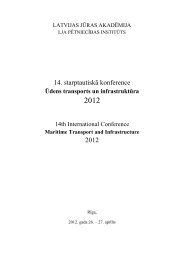Create successful ePaper yourself
Turn your PDF publications into a flip-book with our unique Google optimized e-Paper software.
IntroductionDue to the difficulty of working conditions on the ship, air conditioning and ventilation systems aremore important instead of other systems. The external air conditions are likely to be changeable accordingto the motion of the ship. This situation increases the importance of the control systems in airconditioning applications. The heating or cooling loads change depending on the changes in externalweather conditions on the ship and the ship speed. In this study, after derivation of the mathematicalmodel, the simulation with PID controller is aimed to be made in order to determine the air conditioningsystem that achieves the desired thermal conditions depending on the change of the air conditions.Reaching to the saturation of the temperature and humidity response of the system, distortion effects anddynamic responses are modeled and controlled for each room individually. Therefore, the systemperformance of the ship is observed in an integrated way.In the last two decades, numerous studies have been made related with the modeling and controllingof the HVAC systems. The simulations with on-off control method using the transfer function of thesystem for the control of the air conditioning room temperature has been carried out by Cherchas [1].Zhang has modeled a transfer function of an environment of livestock. With the acceptation of thelinearity of the system, the simulation results belonged to the heating and ventilation system has beenachieved by Zhang [2].House has carried out a discrete time optimal control method for the control of the temperature inany air-conditioning system and energy saving has been obtained from this method according to the othercontrol method; on/off control [3]. Dexter has designed a self-adjustment controller for air-conditioningsystem applications [4].Kamimura has controlled the temperature of the room, which has specific transfer function, withPID controller by using CAT software, which determines the most suitable PID coefficients for any airconditioningsystem [5]. William has suggested to control the damper of mixture air at the airconditioning system using PID controller due to the using microprocessor based electronic controller isbetter for the energy efficiency for the control of the buildings [6]. Atkinson and Martino have used a PIDcontroller which he has designed with analog circuit elements, for the control of the humidity, pressureand temperature and air purity in a factory [7].Krakow has controlled the velocity of the compressor and cooling fan by means of PID controller.Then the temperature and humidity of a room have been controlled and after that he has made a study todetermine the PID coefficients analytically [8, 9]. Kaya has presented a model utilizing from theanalytical techniques to solve the control problems of the air conditioning of the complex systems such asworkplaces and buildings [10].In this study, PID controller which is used commonly with successful results in the literature hasbeen used. On the other hand, mathematical models and Simulink blocks gathered in the study arecommon and they make the assessment of the system performance possible with using any controller.Multi-zone air-conditioning systemsThe most prominent air conditioning system used in ships is multi-zone configuration. Central airconditioning source distributes the air to all localities in multi-zone systems. Each region has its owndampers and desired air conditions are obtained by controlling dampers’ ducting openings viathermostats. Air, returning from ducts of each zone, combines and re-enters the central air conditioningsystem in a single channel. The principle of the system is shown in Figure 1 Multi-zone systemscompensate the advantages of dual duct systems with a lower cost.14
















